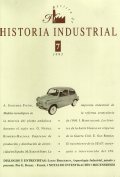La impronta industrial de la reforma arancelaria de 1906
DOI:
https://doi.org/10.1344/rhi.v0i7.18260Resum
Any consideration of the 1906 Tariff Reform must highlight the way in which its contemporaries passed unanimous judgement on it as being a protectionist reform with an industrial vocation. This unanimity of view would explain in part the delay with which the most recent historiography has analyzed it. A relegation which the Reform's gestation in the shadow of the brilliant Cánovas Tariff Reform of 1891 might well have contributed. The aim of this paper is to demonstrate that the Spanish trade policy sketched out at the beginning of the twentieth century was not lacking in attraction. On the one hand it illustrates, by the study of tariff barriers, the advance of industrial protectionism that the policy supposed. Furthermore, it describes how, at the turn of the century, a new political market for protectionism came to be formed, capable of imposing a manufacturing bias onto the Reform. If it can be said that the final unpremeditated result of the Cánovas Reform was industrial protectionism, the Reform of 1906 gave rise to the same result in a manner that was both expected and desired. It reveals a clear industrialist intent and stands in marked contrast to the agrarian orientation of those policies which preceded it.
Descàrregues
Descàrregues
Com citar
Número
Secció
Llicència
The author assigns all rights to the publisher. Creative Commons
The author who publishes in this journal agrees to the following terms:
- The author assigns all intellectual property rights exclusively to the publisher for the entire duration of the applicable intellectual property rights.
- The publisher will distribute the texts under the Creative Commons Attribution License, which allows others to share the work, provided that they acknowledge the authorship, its initial publication in this journal, and the conditions of the license.





